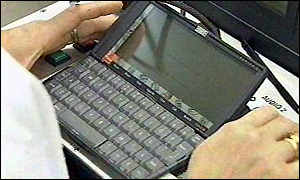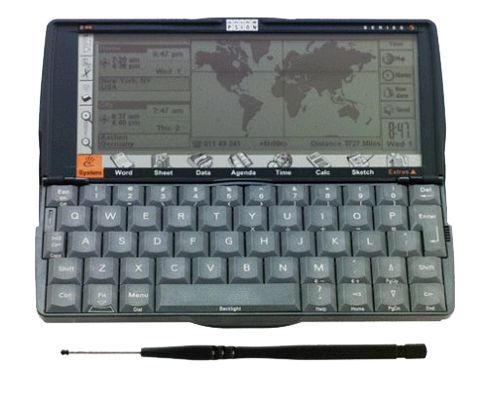The Psion 5: for Writers on the Move
 In 1997, a small electronic device that could have revolutionized the writer's world was created in the research department of a small British company. It did come to revolutionize the world of electronic pocket gadgets but was quickly overcome by another company's products. The device was the Psion 5 and later, the 5MX. The reason it was quickly overcome was because it was marketed not to writers but to businesspeople, and not as the world's lightest laptop but as an agenda and personal digital information organizer, the very class of device that would later come to be known by the name of the device that would dominate the market: the palm pilot.
In 1997, a small electronic device that could have revolutionized the writer's world was created in the research department of a small British company. It did come to revolutionize the world of electronic pocket gadgets but was quickly overcome by another company's products. The device was the Psion 5 and later, the 5MX. The reason it was quickly overcome was because it was marketed not to writers but to businesspeople, and not as the world's lightest laptop but as an agenda and personal digital information organizer, the very class of device that would later come to be known by the name of the device that would dominate the market: the palm pilot.
In many ways the Palm Pilot and successor models of Palm, Handspring, and similar competitors were superior to the Psion, but in others the Psion remained unsurpassed. One of those was the Psion's utility as a word processor so small you can fit it in your (jacket) pocket, and so well-designed it runs on two double-A batteries for weeks at a time. Its strengths as a word processing device for writers include:
The first four points are the more important to me: I can deal with compatibility issues in other ways, but it's the first four points that made the Psion such a revolutionary piece of writing equipment for writers. Not only can you carry the thing in your pocket, but you can write for ages on the built-in keyboard without having to mess with additional equipment, and the batteries last for a long, long time. I quickly found myself using it to write my short stories, working on them as inspiration came to me: on buses, while waiting for trains, as I was struck by inspiration. I would not have been able to do the same had I been forced to carry around a heavy laptop, turn it on, wait for it to boot, and so on. The Psion was on as soon as I opened the cover, ready to write, before the idea faded from my mind.
Other Software
Besides the Word Processing software, the primary reason I carry one around, the Psion has spreadsheet capability and other software now common on PDAs: agenda, task list, addresses, alarms, and so on. The Psion can sync over an infrared link (something I've never had reason to do), or print directly to an infrared-equipped printer. It can not show photos, surf the internet, download email over wireless connections, and has a black and white screen, not color. These things date the Psion relative to its more modern successors. But modern equipment that provides such functionality does so at the expense of battery life, and indeed, many modern Palm PDAs have a battery life of no more than a day, or several hours if the wireless internet connection is active. These things are not useful to me, and I prefer the true portability of the Psion.

Screen and Keyboard
Moreover, the built-in keyboard is indispensable. Sometimes when I get tired of the small keyboard I dream of a Palm with an optional keyboard. The advantage would be the full- or nearly-full sized keyboard. But the disadvantage would be additional batteries, more time spent setting up and connecting the additional keyboard, and the inability to whip the thing out on a bus, since these setups require a table on which to set the PDA-with-keyboard. The Psion comes out on top again. On a similar note, the Psion is built around a screen that is wider than it is tall, facilitating sentence writing. Modern Palms and Ipaq-type PDAs are taller than they are wide. This format facilitates calendars and address lists, and perhaps even the reading of email, but it does not facilitate writing. Only the Palm Lifedrive permits a horizontal interface, but it's not perfect and costs nearly $500. And forget about trying to write on a Palm using the stylus and the graffitti interface: it's painstakingly slow.
Batteries and Disk Space
The Psion runs on two double-As and one watch battery (about the size of a quarter) for backup. Unlike better, more modern designs, when the two double-As die, the watch battery begins to drain. On more than one occasion when the Psion went unused for long periods of time, I would return to find all three batteries drained and my files lost. I worked around this problem by first storing all my files on the Compact Flash card, and afterwards, by purchasing the AC adaptor for my Psion and leaving it plugged in when I didn't intend to use it for longer periods of time.
Backing Up and Synchronizing
Maddeningly, Psion the company only ever produced synchronization software for the Windows operating system in spite of repeated appeals by Macintosh and later Linux users. The latter eventually developed their own solution. It's called PLPTools at the command line and Kpsion with a GUI (the latter needs the former). Mac users don't have it easy but can try Java Psion Link, a Java-based program, but I was never able to get it to work for me, the problem being in adapting the old-style serial cable connection to a modern USB connection. I suspect if I had been able to overcome that challenge, the software would have worked for me, but even a Serial-USB adaptor didn't allow me to connect. Windows users of course have access to the original software, which even permits you to translate documents from Psion to Windows format (Word, Excel). PLPtools and Kpsion provide similar functionality for Linux users. I've used it both from the command line and via the excellent kioslave module for the konqueror browser to transfer files between the Psion and my desktop. SUSE Linux provides this package preconfigured and it has worked wonderfully for me. When I don't have my Linux box convenient to me, I export my Epoc Word documents to text and save them to the flash disk, and transfer the docs that way.
Comparisons
The Psion is getting old, there's no doubt about it. So I've looked around for its eventual replacement, and have found nothing. The Psion lost out because other PDAs were smaller and lighter, and graffiti is a good-enough mechanism for entering addresses or appointments. But I can't use them to write. They're more expensive, require charging all the time, and offer "features" that aren't important to me like the ability to show color photos on their little screens. I couldn't care less. I could use one with an external keyboard, but not without a table to set it on and besides, they require carrying around two things, not one. The Dana Neo has interested me for some time, but it too, pales in comparison to the Psion 5: In its advantage, it runs on the Palm operating system, has a wide enough screen, and a full keyboard that is very likely nicer to type on than the Psion's. But in getting the full keybaord I lose portability: the Dana is nearly as big as a laptop, and if you're going to carry something that big, why not just carry the whole laptop? And it costs about $300.
For that matter, there are small enough laptops now. The Sharp MP30 and the Sony VAIO TX are two of them - small enough to serve as an external USB drive for another computer, and I know for a fact that they run Linux (a plus, if I have to carry around a laptop). But we're back to the problems of laptops - booting up, battery life, problems suspending to disk, and so on, not to mention that even the smallest laptops require heavy transformer power cables to accompany them, diminishing some of the utility of carrying them around.
The Final Word
So for the moment, the Psion remains unsurpassed for a writer intent on being able to produce on the spot and on the road. And so it remains in my bag or in my pocket for writing short stories at the moment inspiration arises. I hope my Psion hangs in there until technology catches up with inspiration. A great PDA perhaps the Psion never was, but for writers it remains decades ahead of its time.
Trackbacks
The author does not allow comments to this entry

Comments
Display comments as Linear | Threaded